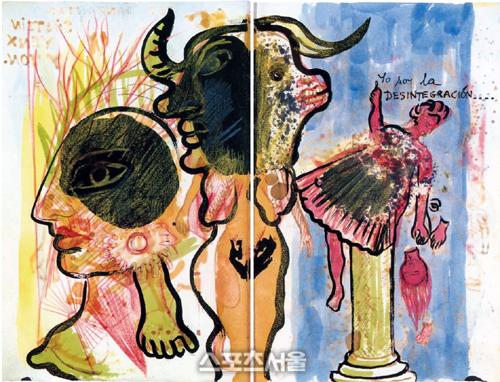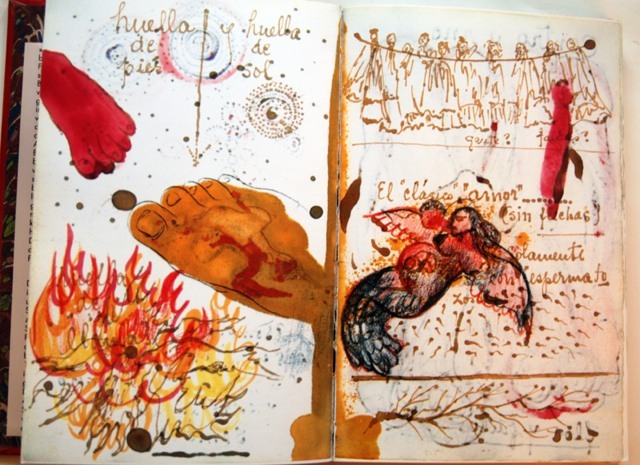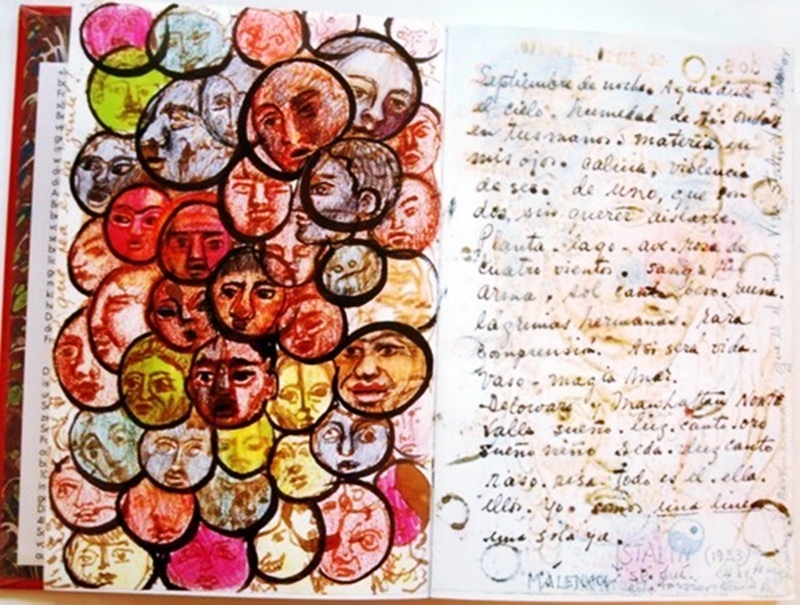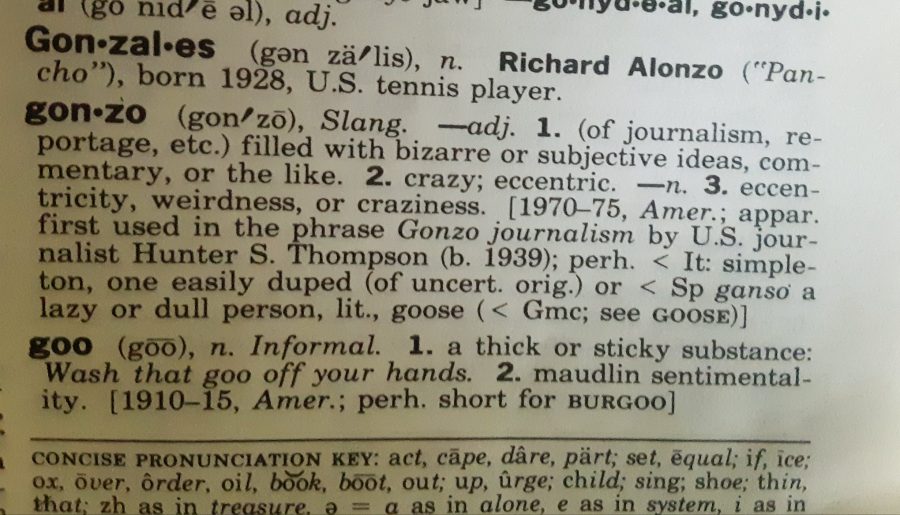Tangled Up in Blue: Deciphering a Bob Dylan Masterpiece
Dylan’s “Tangled Up in Blue” strikes a middle point between his more surreal lyrics of the ‘60s and his more straightforward love songs, and as Polyphonic’s recent video taking a deep dive into this “musical masterpiece” shows, that combination is why so many count it as one of his best songs.
It is the opening track of Blood on the Tracks, the 1975 album that critics hailed as a return to form after four middling-at-best albums. (One of them, Self-Portrait, earned Dylan one of critic Greil Marcus’ best known opening lines: “What is this shit?”–in the pages of Rolling Stone no less.)
Blood on the Tracks is one of the best grumpy, middle-age albums, post-relationship, post-fame, all reckoning and accountability, a survey of the damage done to oneself and others, and “Tangled” is the entry point. Dylan’s marriage to Sara Lowndes Dylan was floundering after eight years–affairs, drink, and drugs had estranged the couple. Dylan would later say that “Tangled” “took me ten years to live and two years to write.”
It would also take him two studios, two cities, and two band line-ups to get working. A version recorded in New York City is slower, lower (in key), and more like one of his guitar-only folk tunes. In December of 1974, Dylan returned home to Minnesota and played the songs to his brother, who wasn’t impressed and suggested he rerecord. The version we know is faster, brighter, janglier, and as Polyphonic explains, sung at a key nearly too high for Dylan. But it’s that wild, near exasperation of reaching those notes that gives the song its lifeblood.
And he also reworked the lyrics, removing whole verses and changing others, until the finished version is, indeed, tangled. It jumps back and forth from present to past to wishful future, verse to verse, and even line to line.
The pronouns change too–the “she” is sometimes the lost love, sometimes a woman who reminds the singer of the former. The further he goes to get away from his first love, the more he meets visions of her elsewhere.
Then there’s the details of the travels and the jobs the narrator takes on, leaving fans to parse which are true and which are not (Sara Lowndes, for example, was working at a Playboy club–the “topless place”–when he met her). And even if we could know who the man is in verse six who “started into dealing with slaves”…would it make any difference?
In the end the song feels universal because it is both so specific and so intentionally confounding. “Tangled Up in Blue” affects so many of its listeners, yours truly included, because it recreates the way memories nestle in our minds, not as a linear sequence but as a kaleidoscope of images and feelings.
Related Content:
Watch Joan Baez Endearingly Imitate Bob Dylan (1972)
Hear Bob Dylan’s Newly-Released Nobel Lecture: A Meditation on Music, Literature & Lyrics
Ted Mills is a freelance writer on the arts who currently hosts the artist interview-based FunkZone Podcast and is the producer of KCRW’s Curious Coast. You can also follow him on Twitter at @tedmills, read his other arts writing at tedmills.com and/or watch his films here.
A Mesmerizing Trip Across the Brooklyn Bridge: Watch Footage from 1899
It’s hardly original advice but bears repeating anyway: no one visiting New York should leave, if they can help it, before they cross the Brooklyn Bridge—preferably on foot, if possible, and at a reverential pace that lets them soak up all the Neo-gothic structure’s storied history. Walk from Manhattan to Brooklyn, then back again, or the other away around, since that’s what the bridge was built for—the commutes of a nineteenth century bridge-but-not-yet-tunnel crowd (the first NYC subway tunnel didn’t open until 1908).
In 1899, filmmakers from American Mutoscope and Biograph elected for a mode of travel for a New York century, putting a camera at “the front end of a third rail car running at high speed,” notes a 1902 American Mutoscope catalogue. They accelerated the tour to the pace of a modern machine, chosing the Manhattan to Brooklyn route. “The entire trip consumes three minutes of time, during which abundant opportunity is given to observe all the structural wonders of the bridge, and far distant river panorama below.” (See one-third of the trip just below.)
Filmmaker Bill Morrison looped excerpts of those three New York minutes and extended them to nine in his short, stereoscopic journey “Outerborough,” at the top, commissioned by The Museum of Modern Art in 2005 and scored with original music by Todd Reynolds. Taking the 1899 footage as its source material, the film turns a rapid transit tour into a moving mandala, a fractal repetition at frighteningly faster and faster speeds, of the bridge’s most mechanical vistas—the views of its looming, vaulted arches and of the steel cage surrounding the tracks.
One of the engineering wonders of the world, the Brooklyn Bridge opened 136 years ago this month, on May 24th, 1883. The first person to walk across it was the woman who oversaw its construction for 11 of the 14 years it took to build the bridge. After designer John Roebling died of tetanus, his son Washington took over, only to succumb to the bends during the sinking of the caissons and spend the rest of his life bedridden. Emily, his wife, “took on the challenge,” notes the blog 6sqft, consulting with her husband while actively supervising the project.
She “studied mathematics, the calculations of catenary curves, strengths of materials and the intricacies of cable construction.” On its opening day, Emily walked the bridge’s 1,595 feet, from Manhattan to Brooklyn, “her long skirt billowing in the wind as she showed [the crowd] details of the construction,” writes David McCullough in The Great Bridge. Six days later, an accident caused a panic and a stampede that killed twelve people. Some months later, P.T. Barnum’s Jumbo led a parade of 21 elephants over the bridge in a stunt to prove its safety.
Barnum’s theatrics were surprisingly honest—the bridge may have needed selling to skeptical commuters, but it needed no hype. It outlived most of its contemporaries, despite the fact that it was built before engineers understood the aerodynamic properties of bridges. The Roeblings designed and built the bridge to be six times stronger than it needed to be, but no one could have foreseen just how durable the structure would prove.
It elicited a fascination that never waned for its palpable strength and beauty, yet fewer of its admirers chose to document the journey that has taken millions of Brooklynites over the river to lower Manhattan, by foot, bike, car, and yes, by train. Leave it to that futurist for the common man, Thomas Edison, to film the trip. See his 1899 footage of Brooklyn to Manhattan by train just above.
Related Content:
Immaculately Restored Film Lets You Revisit Life in New York City in 1911
An Online Gallery of Over 900,000 Breathtaking Photos of Historic New York City
New York City: A Social History (A Free Online Course from N.Y.U.)
Josh Jones is a writer and musician based in Durham, NC. Follow him at @jdmagness
Discover Friedrich Nietzsche’s Curious Typewriter, the “Malling-Hansen Writing Ball” (Circa 1881)

During his final decade, Friedrich Nietzsche’s worsening constitution continued to plague the philosopher. In addition to having suffered from incapacitating indigestion, insomnia, and migraines for much of his life, the 1880s brought about a dramatic deterioration in Nietzsche’s eyesight, with a doctor noting that his “right eye could only perceive mistaken and distorted images.”
Nietzsche himself declared that writing and reading for more than twenty minutes had grown excessively painful. With his intellectual output reaching its peak during this period, the philosopher required a device that would let him write while making minimal demands on his vision.
So he sought to buy a typewriter in 1881. Although he was aware of Remington typewriters, the ailing philosopher looked for a model that would be fairly portable, allowing him to travel, when necessary, to more salubrious climates. The Malling-Hansen Writing Ball seemed to fit the bill:
In Dieter Eberwein’s free Nietzches Screibkugel e‑book, the vice president of the Malling-Hansen Society explains that the writing ball was the closest thing to a 19th century laptop. The first commercially-produced typewriter, the writing ball was the 1865 creation of Danish inventor Rasmus Malling-Hansen, and was shown at the 1878 Paris Universal Exhibition to journalistic acclaim:
“In the year 1875, a quick writing apparatus, designed by Mr. L. Sholes in America, and manufactured by Mr. Remington, was introduced in London. This machine was superior to the Malling-Hansen writing apparatus; but the writing ball in its present form far excels the Remington machine. It secures greater rapidity, and its writing is clearer and more precise than that of the American instrument. The Danish apparatus has more keys, is much less complicated, built with greater precision, more solid, and much smaller and lighter than the Remington, and moreover, is cheaper.”
Despite his initial excitement, Nietzsche quickly grew tired of the intricate contraption. According to Eberwein, the philosopher struggled with the device after it was damaged during a trip to Genoa; an inept mechanic trying to make the necessary repairs may have broken the writing ball even further. Still, Nietzsche typed some 60 manuscripts on his writing ball, including what may be the most poignant poetic treatment of typewriters to date:
“THE WRITING BALL IS A THING LIKE ME:
MADE OF IRON YET EASILY TWISTED ON JOURNEYS.
PATIENCE AND TACT ARE REQUIRED IN ABUNDANCE
AS WELL AS FINE FINGERS TO USE US.”
In addition to viewing several of Nietzsche’s original typescripts at the Malling-Hansen Society website, those wanting a closer look at Nietzsche’s model can view it in the video below.
Note: This post originally appeared on our site in December 2013.
Ilia Blinderman is a Montreal-based culture and science writer. Follow him at @iliablinderman.
Related Content:
Mark Twain Wrote the First Book Ever Written With a Typewriter
The Keaton Music Typewriter: An Ingenious Machine That Prints Musical Notation
The Enduring Analog Underworld of Gramercy Typewriter
What is Camp? When the “Good Taste of Bad Taste” Becomes an Aesthetic
Even if you don’t care about high fashion or high society — to the extent that those two things have a place in the current culture — you probably glimpsed some of the coverage of what attendees wore to the Met Gala earlier this month. Or perhaps coverage isn’t strong enough a word: what most of the many observers of the Metropolitan Museum of Art’s Costume Institute annual fundraising gala did certainly qualified as analysis, and in not a few cases tipped over into exegesis. That enthusiasm was matched by the flamboyance of the clothing worn to the event — an event whose co-chairs included Lady Gaga, a suitable figurehead indeed for a party that this year took on the theme of camp.
But what exactly is camp? You can get an in-depth look at how the world of fashion has interpreted that elaborate and entertaining but nevertheless elusive cultural concept in the Met’s show Camp: Notes on Fashion, which runs at the Met Fifth Avenue until early September.
“Susan Sontag’s 1964 essay Notes on ‘Camp’ provides the framework for the exhibition,” says the Met’s web site, “which examines how the elements of irony, humor, parody, pastiche, artifice, theatricality, and exaggeration are expressed in fashion.” But for a broader understanding of camp, you’ll want to go back to Sontag’s and read all of the 58 theses it nailed to the door of the mid-1960s zeitgeist.
According to Sontag, camp is “not a natural mode of sensibility” but a “love of the unnatural: of artifice and exaggeration.” It offers a “way of seeing the world as an aesthetic phenomenon.” Most anything manmade can be camp, and Sontag’s list of examples include Tiffany lamps, “the Brown Derby restaurant on Sunset Boulevard in L.A.,” Aubrey Beardsley drawings, and old Flash Gordon comics. Elevating style “at the expense of content,” camp is suffused with “the love of the exaggerated, the ‘off,’ of things-being-what-they-are-not.” Camp is not irony, but it “sees everything in quotation marks.” The essential element of camp is “seriousness, a seriousness that fails.” Camp “asserts that good taste is not simply good taste; that there exists, indeed, a good taste of bad taste.”
“When Sontag published ‘Notes on Camp,’ she was fascinated by people who could look at cultural products as fun and ironic,” says Sontag biographer Benjamin Moser in a recent Interview magazine survey of the subject. And though Sontag’s essay remains the definitive statement on camp, not everyone has agreed on exactly what counts and does not count as camp in the 55 years since its publication in the Partisan Review. “Camp to me means over-the-top humor, usually coupled with big doses of glamour,” says fashion designer Jeremy Scott in the same Interview article. “To be interesting, camp has to have some kind of political consciousness and self-awareness about what it’s doing,” says filmmaker Bruce Labruce, challenging Sontag’s description of camp as apolitical.
And what will become of camp in the all-digitizing 21st century, when many eras increasingly coexist on the same culture plane? Our time “has cannibalized camp,” says cultural history professor Fabio Cleto, “but to say that it’s no longer camp because its aesthetics have gone mainstream is an overly simplistic reading. Camp has always been mourning its own death.” Even so, some of camp’s most high-profile champions have cast doubt on its viability. The phrase “good taste of bad taste” brings no figure to mind more quickly than Pink Flamingos and Hairspray director John Waters (who speaks on the origin of his good taste in bad taste in the Big Think video above). But even he speaks pessimistically to Interview about camp’s future: “Camp? Nothing is so bad it’s good now that we have Trump as president. He even ruined that.”
Related Content:
Why So Many People Adore The Room, the Worst Movie Ever Made? A Video Explainer
David Foster Wallace on What’s Wrong with Postmodernism: A Video Essay
The Star Wars Holiday Special (1978): It’s Oh So Kitsch
Susan Sontag’s 50 Favorite Films (and Her Own Cinematic Creations)
John Waters Talks About His Books and Role Models in a Whimsical Animated Video
Based in Seoul, Colin Marshall writes and broadcasts on cities, language, and culture. His projects include the book The Stateless City: a Walk through 21st-Century Los Angeles and the video series The City in Cinema. Follow him on Twitter at @colinmarshall or on Facebook.
Discover Frida Kahlo’s Wildly-Illustrated Diary: It Chronicled the Last 10 Years of Her Life, and Then Got Locked Away for Decades

When we admire a famous artist from the past, we may wish to know everything about their lives—their private loves and hates, and the inner worlds to which they gave expression in canvases and sculptures. A biography may not be strictly necessary for the appreciation of an artist’s work. Maybe in some cases, knowing too much about an artist can make us see the autobiographical in everything they do. Frida Kahlo, on the other hand, fully invited such interpretation, and made knowing the facts of her life a necessity.

She can hardly “be accused of having invented her problems,” writes Deborah Solomon at The New York Times, yet she invented a new visual vocabulary for them, achieving her mostly posthumous fame “by making her unhappy face the main subject of her work.”
Her “specialty was suffering”—her own—“and she adopted it as an artistic theme as confidently as Mondrian claimed the rectangle or Rubens the corpulent nude.” Kahlo treated her life as worthy a subject as the respectable middle-class still lifes and aristocratic portraits of the old masters. She transfigured herself into a personal language of symbols and surreal motifs.

This means we must peer as closely into Kahlo’s life as we are able if we want to fully enter into what Museum of Modern Art curator Kirk Varnedoe called “her construction of a theater of the self.” But we may not feel much closer to her after reading her wildly-illustrated diary, which she kept for the last ten years of her life, and which was locked away after her death in 1954 and only published forty years later, with an introduction by Mexican novelist Carlos Fuentes. The diary was then republished by Abrams in a beautiful hardcover edition that retains Fuentes’ introduction.

If you’re looking for a historical chronology or straightforward narrative, prepare for disappointment. It is, writes Kathryn Hughes at The Telegraph, a diary “of a very particular kind. There are few dates in it, and it has nothing to say about events in the external world—Communist Party meetings, appointments at the doctor’s or even trysts with Diego Rivera, the artist whom Kahlo loved so much that she married him twice. Instead it is full of paintings and drawings that appear to be dredged from her fertile unconscious.”

This descriptions suggests that the diary substitutes the image for the word, but this is not so—it is filled with Kahlo’s experiments with language: playful prose-poems, witty and cryptic captions, free-associative happy accidents. Like the visual autobiography of kindred spirit Jean-Michel Basquiat, her private feelings must be inferred from documents in which image and word are inseparable. There are “neither startling disclosures,” writes Solomon, “nor the sort of mundane, kitchen-sink detail that captivates by virtue of its ordinariness.” Rather than exposition, the diary is filled, as Abrams describes it, with “thoughts, poems, and dreams… along with 70 mesmerizing watercolor illustrations.”

Kahlo’s diary allows for no “dreamy identification with its subject” notes Solomon, through Instagram-worthy summaries of her dinners or wardrobe woes. Unlike her many, gushing letters to Rivera and other lovers, the “irony is that these personal sketches are surprisingly impersonal.” Or rather, they express the personal in her preferred private language, one we must learn to read if we want to understand her work. More than any other artist of the time, she turned biography into mythology.

Knowing the bare facts of her life gives us much-needed context for her images, but ultimately we must deal with them on their own terms as well. Rather than explaining her painting to us, Kahlo’s diary opens up an entirely new world of imagery—one very different from the controlled self-portraiture of her public body of work—to puzzle over.
Related Content:
Frida Kahlo’s Passionate Love Letters to Diego Rivera
A Brief Animated Introduction to the Life and Work of Frida Kahlo
Josh Jones is a writer and musician based in Durham, NC. Follow him at @jdmagness
Mapping Emotions in the Body: A Finnish Neuroscience Study Reveals Where We Feel Emotions in Our Bodies
“Eastern medicine” and “Western medicine”—the distinction is a crude one, often used to misinform, mislead, or grind cultural axes rather than make substantive claims about different theories of the human organism. Thankfully, the medical establishment has largely given up demonizing or ignoring yogic and meditative mind-body practices, incorporating many of them into contemporary pain relief, mental health care, and preventative and rehabilitative treatments.
Hindu and Buddhist critics may find much not to like in the secular appropriation of practices like mindfulness and yoga, and they may find it odd that such a fundamental insight as the relationship between mind and body should ever have been in doubt. But we know from even a slight familiarity with European philosophy (“I think, therefore I am”) that it was from the Enlightenment into the 20th century.
Now, says Riitta Hari, co-author of a 2014 Finish study on the bodily locations of emotion, “We have obtained solid evidence that shows the body is involved in all types of cognitive and emotional functions. In other words, the human mind is strongly embodied.” We are not brains in vats. All those colorful old expressions—“cold feet,” “butterflies in the stomach,” “chill up my spine”—named qualitative data, just a handful of the embodied emotions mapped by neuroscientist Lauri Nummenmaa and co-authors Riitta Hari, Enrico Glerean, and Jari K. Hietanen.

In their study, the researchers “recruited more than 1,000 participants” for three experiments, reports Ashley Hamer at Curiosity. These included having people “rate how much they experience each feeling in their body vs. in their mind, how good each one feels, and how much they can control it.” Participants were also asked to sort their feelings, producing “five clusters: positive feelings, negative feelings, cognitive processes, somatic (or bodily) states and illnesses, and homeostatic states (bodily functions).”
After making careful distinctions between not only emotional states, but also between thinking and sensation, the study participants colored blank outlines of the human body on a computer when asked where they felt specific feelings. As the video above from the American Museum of Natural History explains, the researchers “used stories, video, and pictures to provoke emotional responses,” which registered onscreen as warmer or cooler colors.

Similar kinds of emotions clustered in similar places, with anger, fear, and disgust concentrating in the upper body, around the organs and muscles that most react to such feelings. But “others were far more surprising, even if they made sense intuitively,” writes Hamer “The positive emotions of gratefulness and togetherness and the negative emotions of guilt and despair all looked remarkably similar, with feelings mapped primarily in the heart, followed by the head and stomach. Mania and exhaustion, another two opposing emotions, were both felt all over the body.”

The researchers controlled for differences in figurative expressions (i.e. “heartache”) across two languages, Swedish and Finnish. They also make reference to other mind-body theories, such as using “somatosensory feedback… to trigger conscious emotional experiences” and the idea that “we understand others’ emotions by simulating them in our own bodies.” Read the full, and fully illustrated, study results in “Bodily Maps of Emotions,” published by the National Academy of Sciences.
Related Content:
How Meditation Can Change Your Brain: The Neuroscience of Buddhist Practice
Josh Jones is a writer and musician based in Durham, NC. Follow him at @jdmagness
Is the Leonardo da Vinci Painting “Salvator Mundi” (Which Sold for $450 Million in 2017) Actually Authentic?: Michael Lewis Explores the Question in His New Podcast

Journalist and bestselling author Michael Lewis (Liar’s Poker, Moneyball, The Big Short) has a new podcast, Against the Rules, that “takes a searing look at what’s happened to fairness—in financial markets, newsrooms, basketball games, courts of law, and much more. And he asks what’s happening to a world where everyone loves to hate the referee.” That is, what happens when we, as a society, lose confidence in the arbiters of truth and fairness?
In Episode 5, Lewis focuses on “Salvator Mundi,” a painting of Jesus Christ attributed to Leonardo da Vinci, which famously sold at auction for $450 million in 2017. Pretty remarkable, considering that some question whether “Salvator Mundi,” is really a Leonardo painting at all. Or, if it is, whether the highly-restored painting still retains any brushstrokes from Leonardo himself. This leads Lewis to ask some intriguing questions about the authenticity of art, and to explore the pressure placed on the referees of art–namely, art historians–to confirm the authenticity of potentially valuable paintings. Below, you can stream the episode, “The Hand of Leonardo.”
As a bonus, we’ve also added an episode that examines how sketchy “customer service” companies mislead people trying to repay their student loans, and how the Trump administration has undermined government agencies designed to protect debt-strapped Americans.
Michael Lewis’ Against the Rules is listed in our new collection, The 150 Best Podcasts to Enrich Your Mind.
If you would like to sign up for Open Culture’s free email newsletter, please find it here. Or follow our posts on Threads, Facebook, BlueSky or Mastodon.
If you would like to support the mission of Open Culture, consider making a donation to our site. It’s hard to rely 100% on ads, and your contributions will help us continue providing the best free cultural and educational materials to learners everywhere. You can contribute through PayPal, Patreon, and Venmo (@openculture). Thanks!


